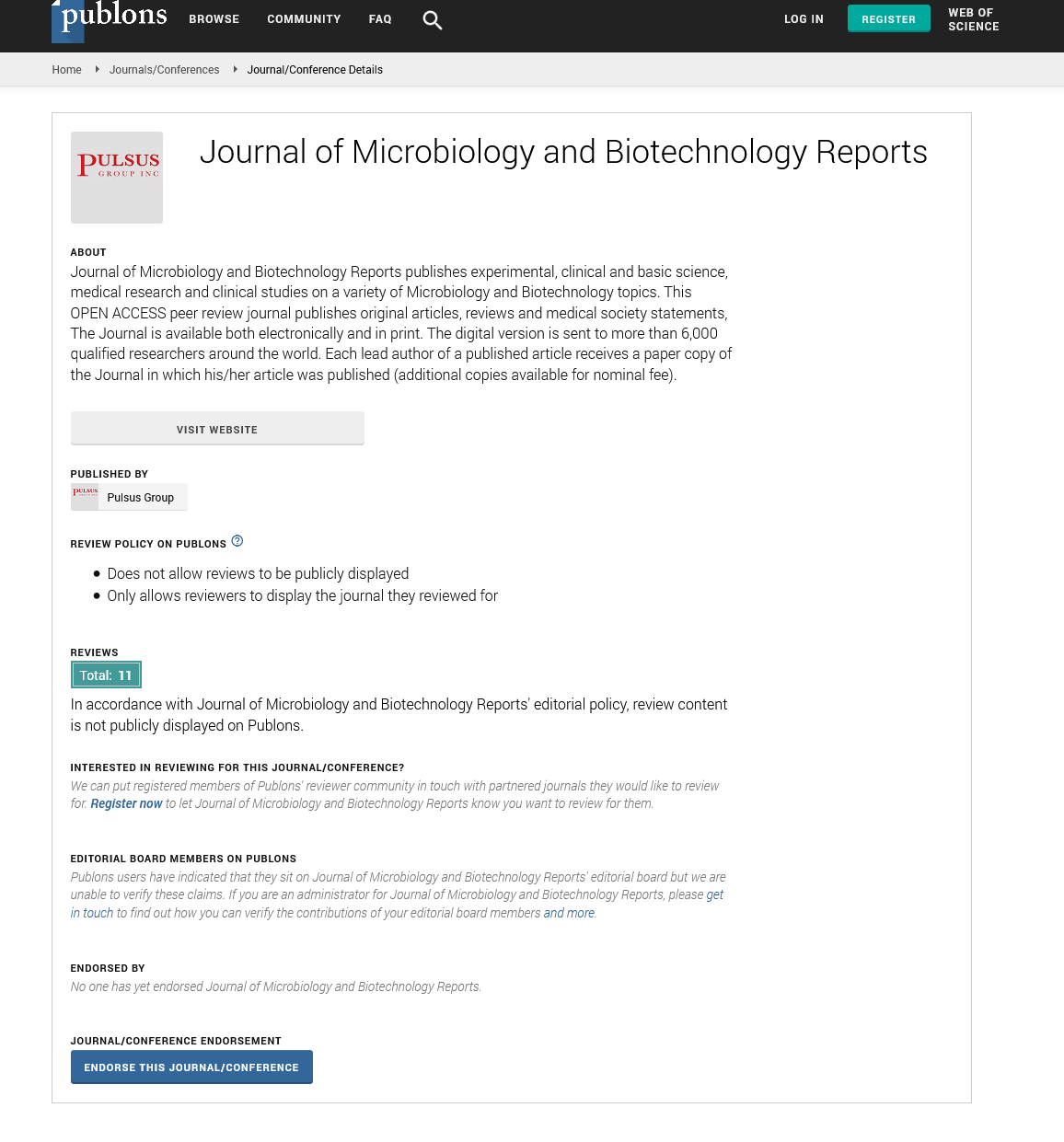Microorganisms associated with laboratory sediments
Received: 16-Jun-2022, Manuscript No. puljmbr-22-5049; Editor assigned: 17-Jul-2022, Pre QC No. puljmbr-22-5049 (PQ); Accepted Date: Jul 15, 2022; Reviewed: 30-Jun-2022 QC No. puljmbr-22-5049 (Q); Revised: 05-Jul-2022, Manuscript No. puljmbr-22-5049 (R); Published: 22-Jul-2022, DOI: 10.37532/puljmbr.2022.5(4).45-46
Citation: Olumide AS. Microorganisms associated with laboratory sediments. J Mic Bio Rep. 2022; 5(4):45-46.
This open-access article is distributed under the terms of the Creative Commons Attribution Non-Commercial License (CC BY-NC) (http://creativecommons.org/licenses/by-nc/4.0/), which permits reuse, distribution and reproduction of the article, provided that the original work is properly cited and the reuse is restricted to noncommercial purposes. For commercial reuse, contact reprints@pulsus.com
Abstract
The fecal indicator bacteria (microbes), Escherichia. coli and Enterococci, are commonly used by Hudson river monitoring programs to quantify the level of sewage infection in estuarine water and to provide information about the health risk to recreators from sewage associated bacteria. It is generally assumed that these microbes do not persist in the water for extended periods of time and that their presence represents a recent release of sewage into the environment. However, much less is known about the abundance and environmental persistence of microbes in sediments, as opposed to the water column, of the Hudson River Estuary. In this study, microbes were quantified, using cultivation-based techniques, in water and sediment samples collected from six locations in the estuary, and the persistence of microbes in sediment was investigated in laboratory incubation experiments. microbes were found to be widely distributed in both sediment and water from the estuary. E. coli and Enterococci displayed correlated abundances in sediment, consistent with sewage infection as a shared source for both microbes in the environment. However, the levels of microbes were not correlated in paired water and sediment samples collected simultaneously from the same sites, suggesting that environmental persistence of these microbes differs in water versus sediment. Enterococci concentrations were found to decrease over time in laboratory incubations of estuarine sediment but remained at detectable levels for weeks after collection. In order to confirm the presence of Enterococci, and rule out the possibility of false positives from the cultivation-based assay, isolated bacterial colonies were characterized using molecular genetic techniques and the vast majority (96%) were confirmed as Enterococci.
Key Words
Escherichia. coli; Enterococci
Introduction
Fifty years ago, the lower Hudson river and laboratory in New York City were commonly considered to be inappropriate for any recreatirecreational contact due to extensive infection, with the river often acting as an open sewer for the surrounding population. Enforcement of the Clean Water Act and major investment in laboratory sand sediment facilities since the 1970s initiated a trend of determining laboratory standards. Long-term environmental monitoring data from New York harbor document the prior history of poor laboratory standards and the resulting improvements in mean seasonal laboratory standards in recent decades. Along with improvements in laboratory standards, there has been a widespread increase in recreational use of the Hudson at official and “unofficial” swimming laboratories, and management action aimed at re-claiming the waterfront and increasing public access to the river. Despite improvement in laboratory sand sediment infrastructure and seasonal laboratory standards, raw and partially treated sewage continues to enter the river and continues to be a management challenge. It is estimated that approximately 27 billion of laboratories in the world, were contaminated with raw sewage, and are still released each year into New York harbor through Combined Sewer Overflow (CSO) events (NYC DEP 2010). Numerous studies from other aquatic systems have demonstrated that waterways contaminated with sewage contain potentially pathogenic strains of microbes such as Salmonella, Campylobacter, and Escherichia coli 0157:H7.
Laboratory and the underlying sediment more quickly than “freeliving” bacteria. Environmental conditions in the sediment are quite different than in the water column, including reduced sunlight, protection against predators, increased nutrient and organic carbon availability, and increased colonizable surfaces. In combination, sediment conditions may lead to increased environmental persistence for microbes, as compared to the water column. For the past two years, data on the persistence of sediment-associated Enterococci and E. coli in the Hudson River has been collected and analyzed in the O’Mullan laboratory at Queens College and the Juhl laboratory at Columbia University. Sediment samples collected from the environment in areas impacted by sewage infection and incubated under a range of temperatures in the laboratory suggest that cultured microbes can remain at detectable levels for weeks to months in Hudson sediment.
Although local monitoring programs typically only measure microbes in water, recreators may also come into contact with contaminated sediment. In addition, the turbulence from large storm events and disturbance from boats or recreators may reintroduce sediment microbes, and associated pathogens, back into the water column creating a connection between laboratory standards and sediment quality. Therefore, studying the persistence patterns of microbes in all compartments of the environment, including sediment, is imperative to understanding the ecology of sewage-associated bacteria in the environment and to interpreting laboratory standard patterns from local monitoring programs.
Conclusion
The results from this study demonstrated that microbes are widely distributed in microbiology laboratory sand sediments and appear to act as a reservoir for sewage associated pathogens ranging from Escherichia coli, Pseudomonas, Bacillus, Acinebacter baumanii, Acetobacter etc. The microbes within this reservoir can persist for weeks, complicating the interpretation of microbes monitoring data. The high microbes content in sediments and attached to particles suggestions that additional research is required to understand the ecology of microbes in laboratory sand sediments and to allow improved approaches to laboratory standard monitoring and modeling. Finally, the molecular research results from this study confirm that cultivation based approaches can be confidently used to enumerate microbes from sediments, supporting this method for studying microbe’s ecology in the environment.





